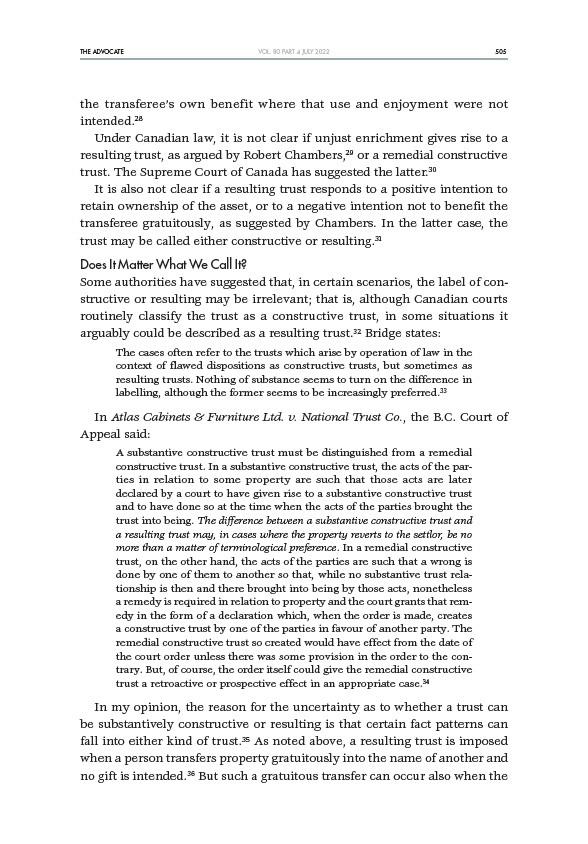
THE ADVOCATE 505
VOL. 80 PART 4 JULY 2022
the transferee’s own benefit where that use and enjoyment were not
intended.28
Under Canadian law, it is not clear if unjust enrichment gives rise to a
resulting trust, as argued by Robert Chambers,29 or a remedial constructive
trust. The Supreme Court of Canada has suggested the latter.30
It is also not clear if a resulting trust responds to a positive intention to
retain ownership of the asset, or to a negative intention not to benefit the
transferee gratuitously, as suggested by Chambers. In the latter case, the
trust may be called either constructive or resulting.31
Does It Matter What We Call It?
Some authorities have suggested that, in certain scenarios, the label of constructive
or resulting may be irrelevant; that is, although Canadian courts
routinely classify the trust as a constructive trust, in some situations it
arguably could be described as a resulting trust.32 Bridge states:
The cases often refer to the trusts which arise by operation of law in the
context of flawed dispositions as constructive trusts, but sometimes as
resulting trusts. Nothing of substance seems to turn on the difference in
labelling, although the former seems to be increasingly preferred.33
In Atlas Cabinets & Furniture Ltd. v. National Trust Co., the B.C. Court of
Appeal said:
A substantive constructive trust must be distinguished from a remedial
constructive trust. In a substantive constructive trust, the acts of the parties
in relation to some property are such that those acts are later
declared by a court to have given rise to a substantive constructive trust
and to have done so at the time when the acts of the parties brought the
trust into being. The difference between a substantive constructive trust and
a resulting trust may, in cases where the property reverts to the settlor, be no
more than a matter of terminological preference. In a remedial constructive
trust, on the other hand, the acts of the parties are such that a wrong is
done by one of them to another so that, while no substantive trust relationship
is then and there brought into being by those acts, nonetheless
a remedy is required in relation to property and the court grants that remedy
in the form of a declaration which, when the order is made, creates
a constructive trust by one of the parties in favour of another party. The
remedial constructive trust so created would have effect from the date of
the court order unless there was some provision in the order to the contrary.
But, of course, the order itself could give the remedial constructive
trust a retroactive or prospective effect in an appropriate case.34
In my opinion, the reason for the uncertainty as to whether a trust can
be substantively constructive or resulting is that certain fact patterns can
fall into either kind of trust.35 As noted above, a resulting trust is imposed
when a person transfers property gratuitously into the name of another and
no gift is intended.36 But such a gratuitous transfer can occur also when the